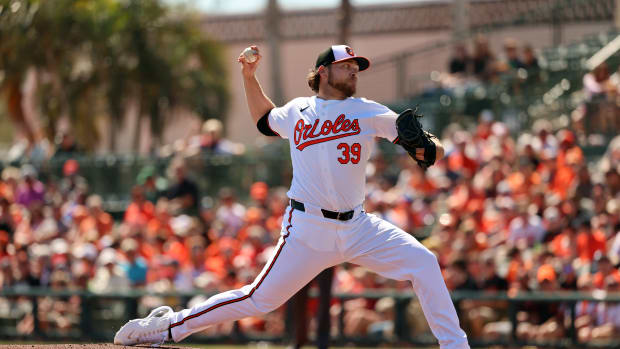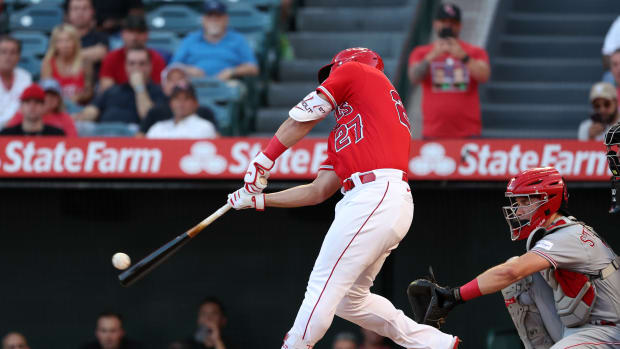Winter Meetings Notebook: This Is Why the Red Sox Need to Trade for Jose Abreu
LAKE BUENA VISTA, Fla. — For a team that won 93 games last year, the Boston Red Sox are in a heap of trouble. They are playing an outdated brand of baseball, desperately need an impact power bat, and match up poorly against the Giancarlo Stanton-fortified Yankees. The void of David Ortiz remains omnipresent more than a year after his last game. The pressure is on president of baseball operations Dave Dombrowski again to do what he does best: make the big move.
“My scouting report on Dave,” said one veteran advisor, “is that he will say no, no, no to your deals until eventually he will say yes.”
But where can Dombrowski find his bat? The best bats on the free agent market are, in order, J.D. Martinez, Carlos Santana and Eric Hosmer. None of them is a perfect fit for Boston. Martinez isn’t a perfect fit because he’s a righthanded opposite-field power hitter. Martinez pulled only eight of his home runs last year. Fenway Park, particularly early and late in the year, does not serve his rightfield gap power stroke well at all.
“I agree it’s a poor fit,” said one NL talent evaluator. “I like the bat, just not as much in Boston. And he’s a DH soon.”
A Martinez addition also would likely displace Jackie Bradley Jr. from centerfield, where Andrew Benintendi would slide over from left to accommodate Martinez—thus weakening the outfield defense, a strong suit.
First basemen Santana and Hosmer are expensive complementary bats—nice additions, but not cutting enough into the Ortiz void.
That leaves the trade market, where Boston’s best bets are Jose Abreu of the White Sox and Marcell Ozuna of the Marlins. Abreu, a gamer and run producer, is the best solution for Dombrowski, but according to one scout, “I was with [White Sox owner] Jerry Reinsdorf the other night and he said he’s not trading Abreu. Of course, with Jerry, maybe that means he is trading him.”
No matter what bat they get, the Red Sox are going to have to revamp their offensive philosophy. The livelier ball and the Launch Angle Revolution have made baseball a game that pivots on home runs, not taking pitches, working the count, stitching together rallies and putting the ball in play—the outdated qualities that Boston needs to address.
The Red Sox finished last in home runs in the American League—while playing their home games in a bandbox with almost no foul territory. That’s tough to do. They had not done that since 1930.
It’s not just about the lack of home runs, though. Boston was a far too passive offensive team, conceding too many pitches when baseball has embraced a “selective aggressive,” flyball-based approach.
On first pitches, for instance, the Red Sox had the fewest hits in baseball (154), almost half as many as Houston (293). It marked the fewest hits on first pitches by any Boston team since such records were first kept in 1988. The Red Sox also were last in 17 first-pitch home runs while the Astros finished with 55.
Swinging less at first pitches didn’t mean their selectivity paid off: they batted .316 when they did hit first pitches, third-worst in baseball and far below the league average of .348.
Their passivity also went beyond whether or not they ambushed pitchers. The Red Sox were passive even in the most hitter-friendly counts. The Red Sox saw the second most pitches with no strikes (0–0, 1–0, 2–0 and 3–0; only the Yankees saw more) and yet they took the fewest swings in those counts. Major league hitters swung at 32.6% of all no-strike pitches, but the Red Sox offered at only 25.8% of them—again, last in baseball.
Like most offensive shortcomings with Boston, this passivity goes back to the Ortiz void. Ortiz retired after a season in which he led the league in doubles, RBI, slugging and OPS. He also brought an attacking style, relying on his sharp baseball intellect to know when to ambush pitchers. His first-pitch slash line in his final season was astounding: .492/.485/.908, which included 32 hits (no Red Sox player this year had more than 19) and six homers. He set the tone. That tone is gone.
The Red Sox did switch hitting coaches, from Chili Davis, who left for the Chicago Cubs, to Tim Hyers, the assistant hitting coach with the Dodgers who served three years as Boston’s minor league hitting instructor.
“Tim knows a lot of them,” said the NL talent evaluator, “and he does a good job, but does the hitting coach have that big of an impact? Maybe some, but it’s mostly about the personnel.”
The Giants and Pirates are examples of two other teams that are playing this outdated brand of baseball. The Giants’ “torture” style of ball that won championships doesn’t work with the livelier ball and fewer balls in play. They, too, need power. Games change on one or two swings now.
In just three years, the number of games won without a home run has dropped by almost 50%, from 787 to 426. Winning without a home run was more rare this year than in any full season since 1960.
On the pitching side, the Red Sox built a staff around lefthanded starters at a time when the Yankees have assembled one of the best righthanded power-hitting lineups of all time. Moreover, as the Dodgers have led the trend toward affording starting pitchers more days off, Boston keeps running their starters out there on the fifth day. Only the Rockies and Rangers (88) started pitchers on the fifth day more than Boston (86). Red Sox starters in September went 11–10 with a 4.33 ERA and their worst WHIP and strikeout-to-walk rate of the season.
Inside the Angels' Shohei Ohtani Deal and Giancarlo Stanton's Trade to the Yankees
What teams had the fewest starts on the fifth day? Three of the final four teams: the Dodgers (45), Yankees (53) and Astros (64, tied with the Padres).
There is much work to be done for Boston, especially because the Yankees have built a monster of a team in this home run-dominant age. Boston needs to address starting pitching depth, bulk up on righthanded relief specialists to try to keep the Yankees in the park, add a utility infielder to caddy for Dustin Pedroia, and, above all, add home run power. The Red Sox ranked among the four worst teams in the league in home runs at five positions: catcher and each infield position.
Dombrowski needs to trade what few valuable prospects he has yet to trade for Abreu. And that’s just the start.
News and Notes
• I don’t know about you, but if I’m an AL East team and I’m looking at playing the Yankees 19 times, I am signing free agent righthanded relief specialist Joe Smith. Against Smith, Giancarlo Stanton, Aaron Judge and Gary Sanchez are a combined 0-for-13 with seven strikeouts.
•With third baseman Chase Headley traded back to San Diego, the Yankees look like the logical landing spot for Todd Frazier on a one-year deal if his multiple-year market doesn’t develop.
•Count Houston among the many teams with interest in Christian Yelich. The Marlins are putting a greater emphasize on moving Ozuna, with less control and more money, but Yelich, who is controlled through 2022, would bring Miami a bigger haul. Houston has Preston Tucker and Derek Fisher on the way, but Yelich is the ready-made lefthanded bat Houston prefers for its righthand-heavy lineup.
Giancarlo Stanton Trade Proves Derek Jeter Might Be Out of His Depth Running the Marlins
• Good news for Dodgers fans: Julio Urias is back in their pitching plans for 2018. The 21-year-old lefthander with a veteran’s touch on his pitches lost most of this year to shoulder surgery. But Los Angeles did not consider the surgery to be a major one, and Urias has been throwing. He is expected to start 2018 behind normal schedule, but will factor into their mid-season plans if all continues to go well.
• It’s fun to think of Manny Machado being traded, but several factors make it unlikely: the lack of teams in position to pay heavily for one year of the infielder (St. Louis?), the track record of owner Peter Angelos not wanting to rebuild, and the generally poor market for hitters. Last year, from December to spring training, the best hitters traded were Travis Shaw, Adam Eaton and Brandon Phillips—not superstars.
• An interesting trade market may be developing among young, controllable starting pitchers, including Michael Fulmer, Gerrit Cole and Chris Archer, the most fascinating case study. He has four more years of control and he has been durable, so he has the most value, but his progression has stagnated. Archer has a 4.05 ERA the past two seasons and without ever developing a strong third pitch has been throwing his slider more and more for three straight seasons—now up to 44%.



































